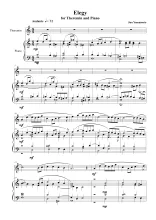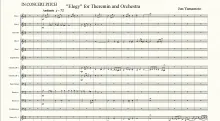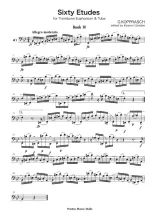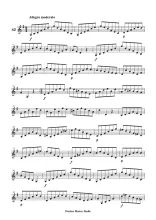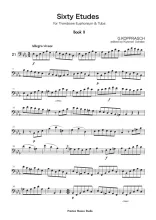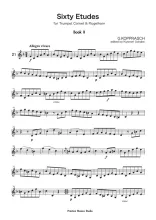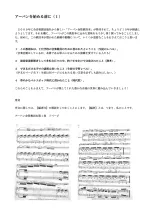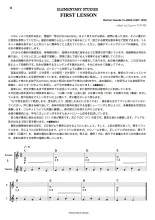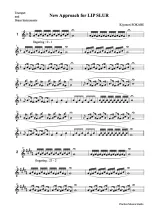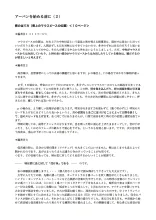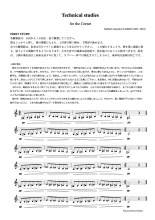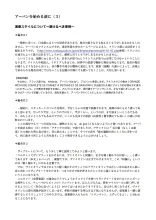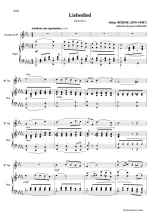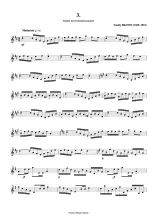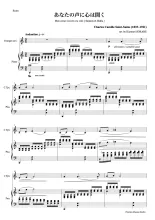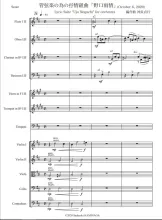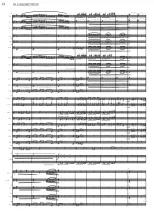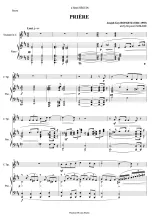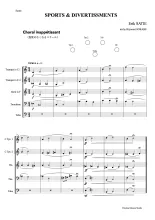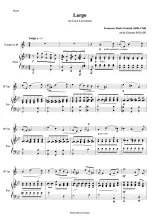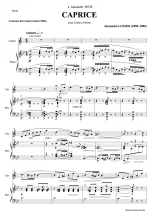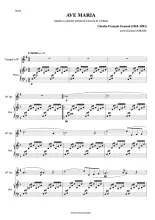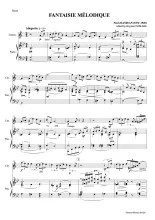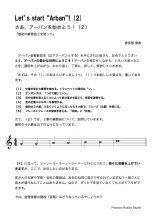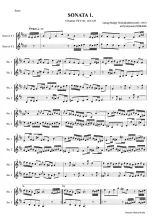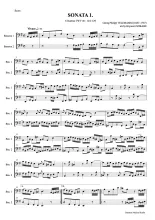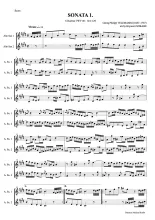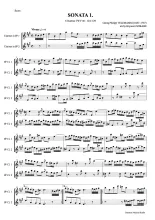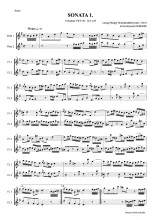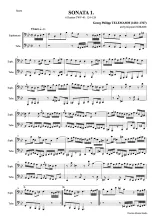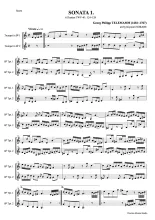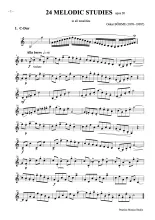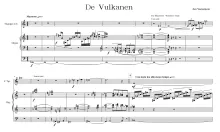New Releases
Our Staff Picks
News
FANTAISIE MÉLODIQUE
JEANJEAN, Paul (arr. SOKABE, Kiyonori)ポール・ジャンジャン(arr. 曽我部清典)
フランスの作曲家ポール・ジャンジャンのメロディック・ファンタジーです。元はオーケストラ伴奏ですが、これはピアノリダクション版です。ジャンジャンの他の作品と同じく、パリ音楽院の学生の技術向上のために作られました。フランス近代の作品を吹きたいけど高音が苦手という方にも、最高音は実音F(カデンツでGesが出てきます)なので、貴重なレパートリーになると思います。
FANTAISIE MÉLODIQUE
JEANJEAN, Paul (arr. SOKABE, Kiyonori)ポール・ジャンジャン(arr. 曽我部清典)
フランスの作曲家ポール・ジャンジャンのメロディック・ファンタジーです。元はオーケストラ伴奏ですが、これはピアノリダクション版です。ジャンジャンの他の作品と同じく、パリ音楽院の学生の技術向上のために作られました。フランス近代の作品を吹きたいけど高音が苦手という方にも、最高音は実音F(カデンツでGesが出てきます)なので、貴重なレパートリーになると思います。
Let's start "Arban" 2
SOKABE, Kiyonori曽我部清典
Explanation : no.2 of Arban's Method.
『アーバンを始める前に』に引き続き、アーバン金管教則本について、わかりやすく詳しく解説していきます。その第2回めは、全音版アーバン金管教則本の17ページ、最初の練習曲の第2番のみ!です。
Duo Sonate nr.1 for 2 horns
TELEMANN, Georg Philipp (arr. SOKABE, Kiyonori)ゲオルグ・フィリップ・テレマン(arr. 曽我部清典)
テレマンの2本のフラウトトラベルソのためのデュオソナタを2本のホルンのために書き直しました。keyが同じなので同時にリリースされたフルート・クラリネット・アルトサキソフォン・バスーンのバージョンと併用することでほとんどの木管楽器で演奏することができます。木管アンサンブルの練習曲としてだけでなく、コンサートにも使える佳作と思います。
Duo Sonate nr.1 for 2 bassoons
TELEMANN, Georg Philipp (arr. SOKABE, Kiyonori)ゲオルグ・フィリップ・テレマン(arr. 曽我部清典)
テレマンの2本のフラウトトラベルソのためのデュオソナタを2本のバスーンのために書き直しました。keyが同じなので同時にリリースされたフルート・クラリネット・アルトサキソフォン・ホルンのバージョンと併用することでほとんどの木管楽器(ホルンを含む)で演奏することができます。木管アンサンブルの練習曲としてだけでなく、コンサートにも使える佳作と思います。
Duo Sonate nr.1 for 2 alto saxophones
TELEMANN, Georg Philipp (arr. SOKABE, Kiyonori)ゲオルグ・フィリップ・テレマン(arr. 曽我部清典)
テレマンの2本のフラウトトラベルソのためのデュオソナタを2本のアルトサキソフォンのために書き直しました。keyが同じなので同時にリリースされたフルート・クラリネット・バスーン・ホルンのバージョンと併用することでほとんどの木管楽器(ホルンを含む)で演奏することができます。木管アンサンブルの練習曲としてだけでなく、コンサートにも使える佳作と思います。
Duo Sonate nr.1 for 2 clarinets
TELEMANN, Georg Philipp (arr. SOKABE, Kiyonori)ゲオルグ・フィリップ・テレマン(arr. 曽我部清典)
テレマンの2本のフラウトトラベルソのためのデュオソナタを2本のクラリネットのために書き直しました。keyが同じなので同時にリリースされたフルート・アルトサキソフォン・バスーン・ホルンのバージョンと併用することでほとんどの木管楽器(ホルンを含む)で演奏することができます。木管アンサンブルの練習曲としてだけでなく、コンサートにも使える佳作と思います。
Duo Sonate nr.1 for 2 flutes
TELEMANN, Georg Philippゲオルグ・フィリップ・テレマン
テレマンの2本のフラウトトラベルソのためのデュオソナタのオリジナル版です。keyが同じなので、このあとリリースされるクラリネット・アルトサックス・ファゴットのバージョンと併用することで、ほとんどの木管楽器で演奏することができます。練習曲としてだけでなく、コンサートにも使える佳作と思います。
Duo Sonate nr.1 for euphonium & tuba
TELEMANN, Georg Philipp (arr. SOKABE, Kiyonori)ゲオルグ・フィリップ・テレマン(arr. 曽我部清典)
テレマンの2本のフラウトトラベルソのためのデュオソナタをユーフォニアムとテューバのために書き直しました。keyが同じなので同時にリリースされた2本のトランペットのバージョンと併用することでトランペットとも演奏することができます。練習曲としてだけでなく、コンサートにも使える佳作と思います。
Duo Sonate nr.1 for 2 trps
TELEMANN, Georg Philipp (arr. SOKABE, Kiyonori)ゲオルグ・フィリップ・テレマン(arr. 曽我部清典)
テレマンの2本のフラウトトラベルソのためのデュオソナタを2本のトランペットのために書き直しました。keyが同じなので同時にリリースされたユーフォニアムとチューバのバージョンと併用することでトランペットとトロンボーンなどで演奏することができます。練習曲としてだけでなく、コンサートにも使える佳作と思います。
24 Melodic studies
BÖHME, Oskarオスカー・ベーメ
オスカル・ベーメの24のメロディックスタディです。長調と短調12ずつ、すべての調性でメロディを歌えるようにするための練習曲です。テンポも表情もバラエティに富んでいます。表現力をつけるためには最適な教則本と思います。トランペット用ですが、すべての金管楽器で演奏可能です。
De Vulkanen (The Volcanos) (Trp. Pipeorgan)
YAMAMOTO, Jun山本準
This piece (about 8 minutes long) was composed with the intention to bring out the rich sound of the pipe organ and trumpet as much as possible. The music starts with Eb by pedal of the organ. Over the arpeggios of the organ, the theme by the trumpet and pedal tone of organ clime up to reach the major triad on F#. In the second part, the right hand of the organ and the trumpet exchange melodies of mainly 16th notes on a constant running of the left hand of the organ. The central sound in this part changes from Bb, Eb, Gb B and D. The melody line also develops in the scale according to the center tone. The music reaches the solo of the trumpet and the organ makes comping to it. The third part begins with the organ's short cadenza. On the persistent ostinato at the lower part of the organ, the trumpet and the organ's right hand exchange lines of 16th notes, increasing tension from the trumpet and the organ's triplet unison to the climax with the trumpet's harmonic glissandos. After the introduction part is reflected after a pause, the gradually piled up chords designated "Placare" change their color little by little, and finally the music concludes quietly on the chord consisting of 8 tones including the Major and Minor triad on the base note of E natural.
This piece has been premiered by Duo Babaar (Trumpet Sogabe Kiyonori, Organ Tsukatani Minako) at Nishikatamachi Church in Tokyo on June 29, 2019.
本作品(演奏時間 約8分)はパイプオルガンとトランペットの豊かな響きを最大限引き出したいという意図の下に作曲された。曲は変ホ音のペダルから始まる序奏に続き、オルガンのアルペジオにのってトランペットとオルガンの低音部のオクターブによる上行する旋律を経て、オルガンの明確な嬰へ音上の長三和音に到達する。第2部分は、オルガンの左手によるコンスタントなスケールにのってオルガンの右手とトランペットが16分音符を中心とした旋律を交換しあう。この部分の中心音は、変ロ音から、変ホ音、変ト音、ロ音を経てニ音に変化していき、それに伴い旋律線もそれぞれの中心音に従った音階において展開して高潮して、トランペットのソロに到達し、これにオルガンが「合いの手」を入れる形となり、最終的にはオルガンはト音上の長三和音、トランペットは嬰ト音に達して休止する。第3部分はオルガンの短いカデンツァをへてオルガン低音部の執拗なオスティナートが始まりトランペットとオルガンの右手によりさらに16分音符を中心としたラインがやり取りされて緊張を増し、トランペットとオルガンの3連符によるユニゾンから、トランペットのハーモニック・グリッサンドを伴うクライマックスに達する。休止ののち序奏部分が再現したあと、Placare(なだめるように)が指定された徐々に積み重なる和音が少しずつ構成を変えながら、最後はホ音上の長三度と短三度を同時に含む8音からなる和音上で静かに曲を閉じる。
本作品は2019年6月29日東京・日本基督教西片町教会において、デュオ・ババール(トランペット 曾我部清典、オルガン 塚谷水無子)により初演された。
